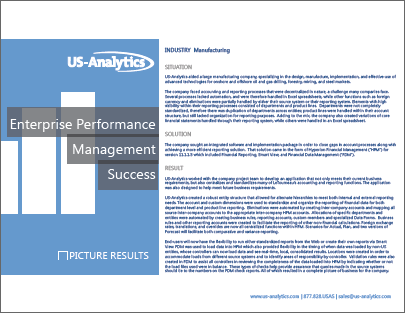Learn how US-Analytics aided a large manufacturing company specializing in the design, manufacture, implementation, and effective use of advanced technologies for onshore and offshore oil and gas drilling, forestry, mining, and steel markets, with their accounting and reporting processes.
TECHNOLOGIES LEVERAGED
Oracle Hyperion Financial Management (HFM) version 11.1.1.3, including Financial Reporting, Smart View and Financial Data Management (FDM).
SITUATION
The company faced accounting and reporting processes that were decentralized in nature, a challenge many companies face. Several processes lacked automation, and were therefore handled in Excel spreadsheets, while other functions such as foreign currency and eliminations were partially handled by either their source system or their reporting system. Elements with high visibility within their reporting processes consisted of departments and product lines. Departments were not completely standardized, therefore there was duplication of departments across entities; product lines were handled within their account structure, but still lacked organization for reporting purposes. Adding to the mix, the company also created variations of core financial statements handled through their reporting system, while others were handled in an Excel spreadsheet.
SOLUTION
The company sought an integrated software and implementation package in order to close gaps in account processes along with achieving a more efficient reporting solution. That solution came in the form of Oracle Hyperion Financial Management (HFM) for version 11.1.1.3 which included Financial Reporting, Smart View, and Financial Data Management (FDM).
RESULT
US-Analytics worked with the company project team to develop an application that not only meets their current business requirements, but also centralizes and standardizes many of the company's accounting and reporting functions. The application was also designed to help meet future business requirements.
US-Analytics created a robust entity structure that allowed for alternate hierarchies to meet both internal and external reporting needs. The account and custom dimensions were used to standardize and organize the reporting of financial data for both department level and product line reporting. Eliminations were automated by creating inter-company accounts and mapping all source inter-company accounts to the appropriate inter-company HFM accounts. Allocations of specific departments and entities were automated by creating business rules, reporting accounts, custom members and specialized Data Forms. Business rules and other reporting accounts were created to facilitate the reporting of other non-financial calculations. Foreign exchange rates, translations, and overrides are now all centralized functions within HFM. Scenarios for Actual, Plan, and two versions of Forecast will facilitate both comparative and variance reporting.
End-users will now have the flexibility to run either standardized reports from the Web or create their own reports via Smart View. FDM was used to load data into HFM which also provided flexibility in the timing of when data was loaded by non-US entities, whose controllers can now load data and see real-time, local, consolidated results. Locations were created in order to accommodate loads from different source systems and to identify areas of responsibility by controller. Validation rules were also created in FDM to assist all controllers in reviewing the completeness of the data loaded into HFM by indicating whether or not the load files used were in balance. These types of checks help provide assurance that queries made in the source systems should tie to the numbers on the FDM check reports. All of which resulted in a complete picture of business for the company.





